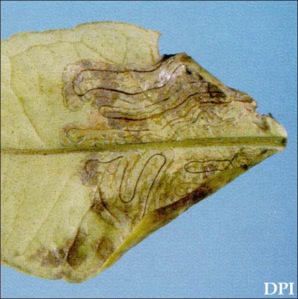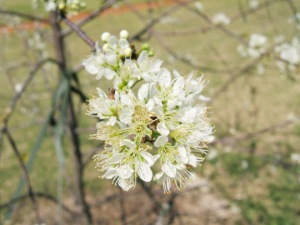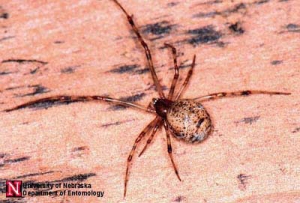A: This question as been asked of me at least six times last week. Every time I saw the damage brought to my office, it was caused by an insect called the citrus leafminer, Phyllocnistis citrella. The trailing lines in the citrus leaves are caused by the larvae of a tiny moth. It is a serious problem for the citrus industry but not really for those of us growing citrus in our landscapes. While it does make the leaves look horrible, the insect carries no disease. Since it feeds within the leave tissue layers, chemical pesticide applications are fairly useless. Removal of all the leaves while they are still green could potentially reduce the amount of nutrients available to the tree. I prefer to hand kill the larvae while it is feeding in the leave tissue. The adult female lays the egg on new leaf tissue so you only need to check new growth. I have effectively diminished the population simply be being a good scout of the plant and hand removing the larvae. I am also suggesting it is good therapy – just a thought! The following is a publication from the University of Florida on the citrus leafminer:
Monthly Archives: March 2015
Q: What is the white blooming tree I see just outside the wooded areas here? I know it is not a dogwood as the flowers are too small
A: I believe you may be talking about the native flatwoods plum, Prunus umbellate. It is a round-topped, deciduous tree, reaching 20 feet in height with a 15-foot spread, which is most often planted for its spectacular display of blooms. Flatwoods plum trees are small trees produce a white, billowy, almost cloud-like appearance when they are clothed in the profuse, small, white flower clusters. These white, half-inch blooms are followed by one-inch-long, edible, purple fruits which vary in flavor from very tart to sweet. These small plums are an important and attractive food source to various forms of wildlife – mostly birds but yes even the occasional, annoying squirrel. They are perfect for cold hardiness zones 8-9 which includes most of Nassau County. Flatwoods plums grow well in full sun to part shade; they tolerate most any type of soil as long as it is well drained. This would be a perfect patio tree just be sure it is out of the area where it would receive the same irrigation as lawns, which would be too much water. Flatwoods plums cannot tolerate salt, even from ocean breezes so keep it away from the direct coastline. It has no major diseases and only occasionally my house tent caterpillars which can easily be hand removed. Flatwoods plums are easy care trees which also require very little pruning to be a beautiful upright tree. It is definitely an underutilized small tree. We have one in the main demonstration garden (James S. Page Governmental Complex) if you want to see it now (March) in full bloom. The attached publication is from the University of Florida: http://edis.ifas.ufl.edu/st521
Q: Are the dust gathering “cobwebs” caused by spiders?
A: Spiders of the family Theridiidae, or “cobweb spiders” are responsible for many of the loose, haphazard looking webs found in the corners of houses, barns, and sheds. The common house spider, Achaearanea tepidariorum (C.L. Koch), may be the most abundant of the several species of spiders living in the company of man in the southeastern United States. They are rather shy spiders displaying no aggression so we need not fear them. My only close encounter was in the shower – sadly the spider did not survive the hot water. I’m just not that fond of sharing my shower with arachnids. Females and juveniles make typical theridiid webs (tangle webs). These webs are frequently made between two adjoining edges of a building, for example, between an eave and a wall. Many individuals may occur in the same area and build nearly contiguous webs covering large areas of eaves, wall space, and window frames. Webs may be built both inside and outside of buildings; when inside, they are frequently a major contributor to the build-up of “cobwebs.” Sheds, barns and stables, in addition to other outdoor dwellings, may have heavy populations of this species. Other characteristic habitats include undersides of highway bridges and culverts. Like most spider webs, the webs of cobweb spiders are sticky. When the spiders move away or die, the abandoned webs start to collect airborne lint and dust. Although
A. tepidariorum belongs to the same family (Theridiidae) as the notorious black widow spiders (Latrodectus spp.), it is not known to be dangerous to humans. One case of serious allergic reaction to the bite of A. tepidariorum is known from Gainesville, Florida. But remember, all spiders carry venom and our reaction will vary from case to case. A single female may produce many pear-shaped light brown eggsacs during the year, which are hung freely in the web. At least in Florida, all stages seem to occur throughout the year. Most of the information provided came from this University



